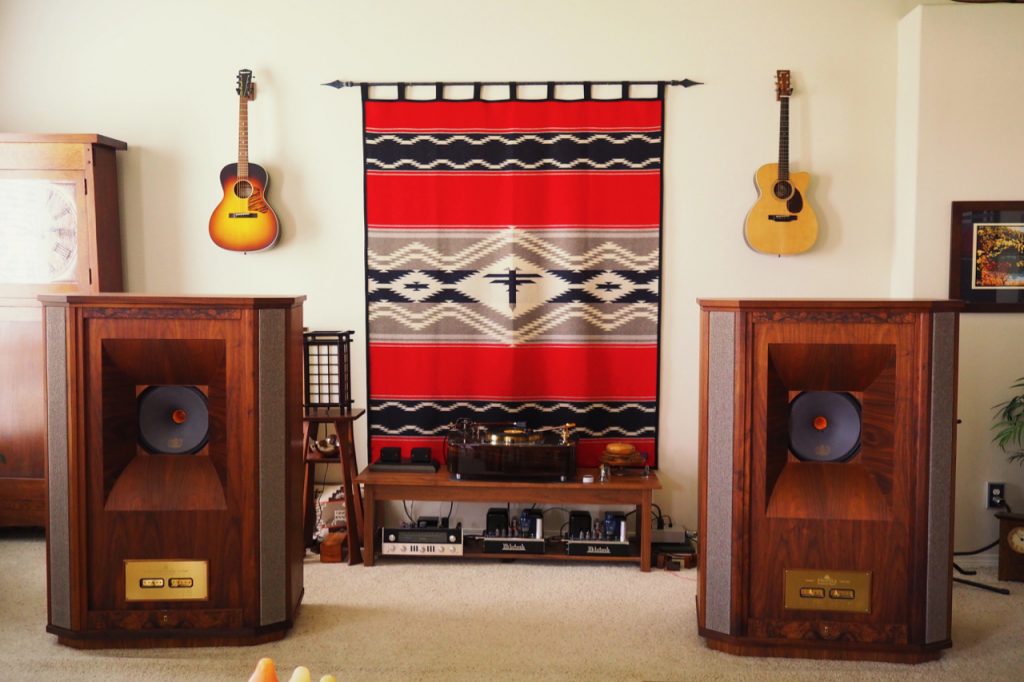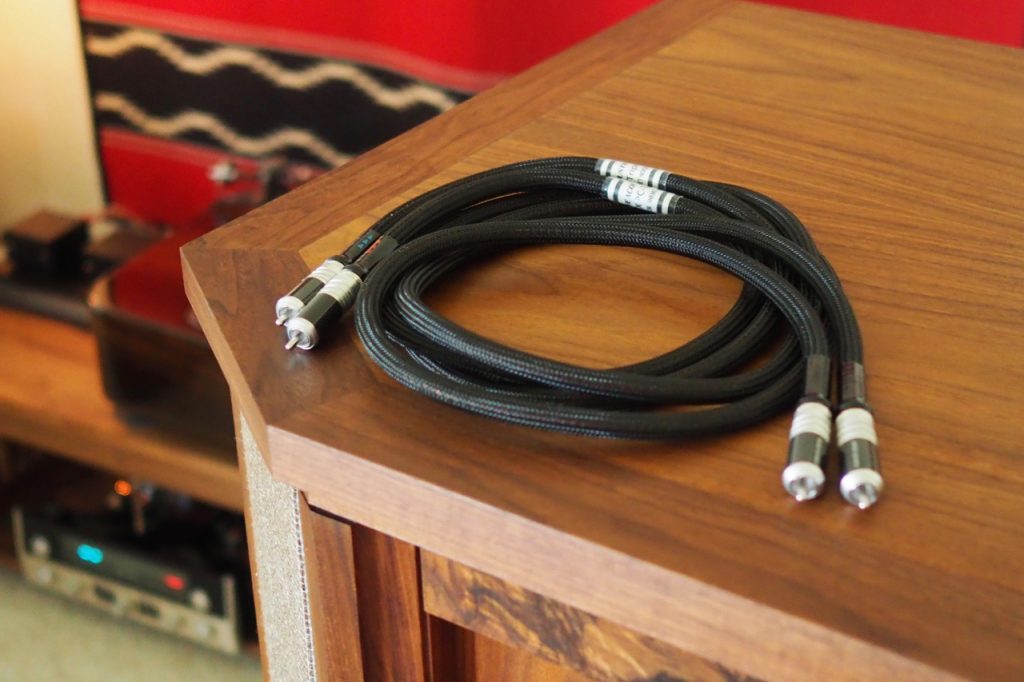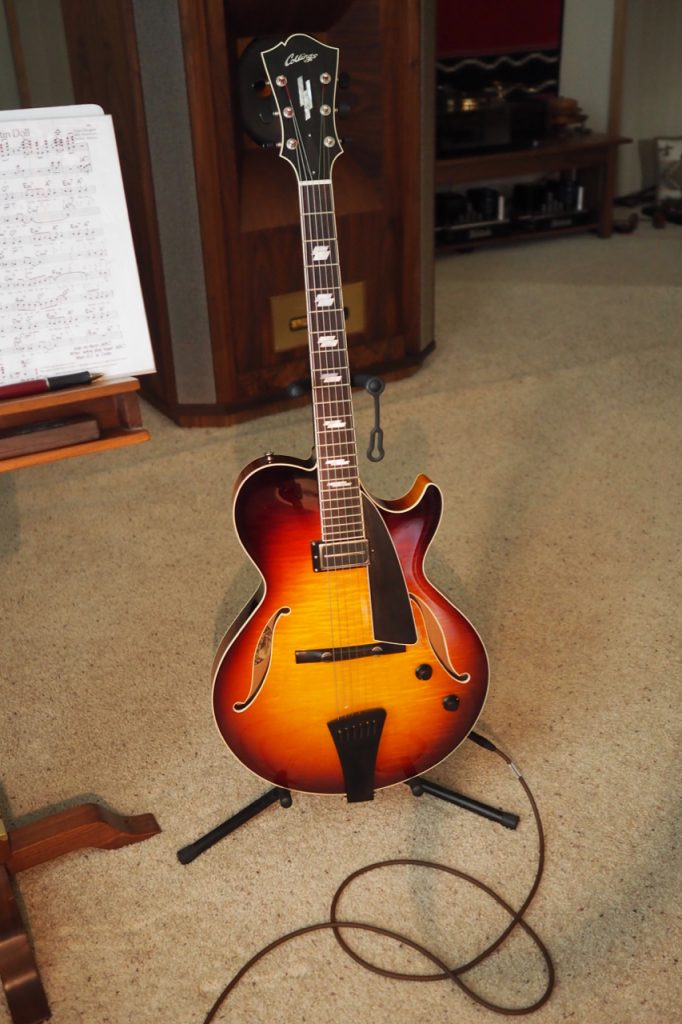In Part 1 and Part 2 of my musings about “high fidelity” in audio I explored how high fidelity is considered to be a measure of how close a stereo system or recording comes to reproducing the live musical event.

Gavin Lazarus (guitar) and friends playing some great jazz standards in Bath, England. If you get a chance to hear Gavin don't miss it, he's terrific!
I broadly defined two aspects of high fidelity in audio, the first being (in Part 1) high fidelity in terms of how close a stereo system or recording comes to accurately reproducing the musical fundamentals of a performance, like timbre, tone color, melody, harmony, rhythm, tempo, and dynamics.

The second aspect of high fidelity in audio I explored (in Part 2) was how close a stereo system or recording comes to accurately reproducing the non-musical “sonics” that are related to a performance, like soundstage, imaging, resolution, soundspace, and transparency.
In those introductory pieces about high fidelity I painted with a very broad brush, purposely ignoring quite a number of important topics one might want to consider, some of which I’ll discuss in this post, and other posts in the future.
High Fidelity in the Listener
One of the topics I avoided in my introductory posts about high fidelity was that of the listeners themselves, which influences both perceptions of high fidelity to musical fundamentals and high fidelity to non-musical “sonics”.
Biological Aspects of Hearing
In Part 1 and Part 2 of my musings on high fidelity I assumed that all listeners had the same acuity of hearing.
The reality is that some people hear things differently than others, and not all listeners will have the same hearing acuity, in the same way that not all people viewing something – say a piece of art work – will have 20/20 visual acuity, or see colors the same way (i.e. color blindness).
From a biological standpoint hearing acuity tends to decline with age, and can be reduced by medical conditions, medications, and exposure to environmental factors like noise.
Genetics and other factors, like how the brain processes sound (a temporal processing disorder, for example), also can affect our hearing acuity.
In the real world the “error bars” (precision) for hearing acuity are quite large.
To learn more about the sorts of factors that affect hearing acuity you can search on “factors affecting hearing acuity” and read some of the scholarly articles about the topic.
Differences in Hearing from the Norm
Every once in a while, I’ll read a comment from someone that reports something contrary from the norm of what other people report hearing when listening to a particular piece of audio equipment.
An imaginary example might be, “I listened to vintage McIntosh MC30 monaural amplifiers in a stereo and I thought they sounded dark and shut in.”, a perception that differs from the norm of those who report MC30’s as sounding vibrant, dynamic, and exciting.

Vintage McIntosh MC30 monaural amplifiers with Sophia Electric 274B rectifiers and NOS GE 6L6GC power tubes.
There’s a number of possibilities when one listener reports different perceptions from other listeners.
In our imaginary MC30 example, one possibility is that particular listener heard MC30’s in an overall stereo system context that was dark and shut in sounding, and they are misattributing that overall stereo system sound to the sound of the MC30’s.
Another possibility is that listener has personal tastes that favors bright and forward sounding equipment, so the listener considers the MC30’s to sound dark and shut in sounding.
Another possibility is that listener has heard MC30’s in a number of systems and still perceives them as dark and shut in sounding, which could indicate that the listener’s hearing acuity is quite different from the norm, as when a person has a condition called presbycusis, where things tend to sound dull, muffled or attenuated to them generally, for example.
I don’t doubt a listener reporting something that differs from the norm, but I do wonder why they heard it differently than the norm, so I can understand what is driving their perceptions.
Everything Sounds the Same
Let’s take another example, one that is the opposite of a listener hearing things differently than the norm, the person who can’t hear any differences between things at all.
A classic example from music includes being tone deaf, where a listener can’t hear the difference between different pitches, with the other extreme being having perfect pitch.
A person who is tone deaf cannot distinguish between musical tones. Being tone deaf is fairly uncommon, and only affects about 4% of the population. Having perfect pitch is even less common, and occurs in less than 1% of the population. Everyone else is somewhere in between.
For everyone else one’s ability to distinguish between pitches is a matter of learning to read music, and training and practice in being able to aurally recognize different pitches.
Tone deafness is a form of amusia, but there are also other conditions where people can’t hear differences in music, like amelodia, where a person cannot recognize melodies, for example.
For more interesting information about tone deafness and perfect pitch I recommend the interesting article Tone Deafness and Perfect Pitch by Chris Aldren, which you can read HERE.

As a specific audio example, there are listeners who say that all wire products sound the same. They don’t hear a difference between different interconnects, speaker cables, or power cords, for example.
A likely explanation for someone not being able to hear what others consider to be easily audible differences is a lack of training and experience in listening for particular traits, which means they just need a little training and experience on what to listen for to be able to hear it.
Another explanation might be that in the context of the stereo equipment they were listening to, that overall the stereo equipment was of such low fidelity that they really couldn’t hear any differences, and they were just accurately reporting what they heard.
Cultural Differences in Hearing
Not all differences in hearing are biological, there’s also differences in how different cultures hear the same musical event.
I will point out that people in different cultures around the world listen to music differently, by placing more attention on listening to certain aspects of music's attributes than is common to other cultures. It might seem surprising, but the truth is that not everyone hears things the same way as you do when listening to the same piece of music.
An example of a cultural difference in hearing would be timbral listening. In Western culture, the conventional way of listening to and interpreting music is for the ear to focus in on pitch and harmony first. Yet in the traditional cultures of Turkey, Africa, and Japan, the listener's ear focuses in on the textures and colors of the music first - that's called timbral listening.

The Blue Mosque in Istanbul.
Another example of a 'cultural' difference in listening comes from an audiophile subculture. For example, some audiophiles have added another aspect of listening to recorded music, which I’ll refer to as 'sonic listening'. In sonic listening the ear is trained to focus in on non-musical recording artifacts first, things like transparency, soundstage, soundspace, and imaging, for example.
None of these emphases on listening to music are right or wrong, good or bad, or anything like that, they just are what they are.
Incorporating Differences in Hearing into High Fidelity
Understanding that differences in perception in musical listening legitimately exist will help you to understand your own listening preferences better, and will ultimately help you to build a Hi-Fi system that will be more satisfying to you during listening sessions.
What if you have biological issues that affect your hearing, what should you do? First of all, don’t worry about it – its ok! Just continue to enjoy music like you always have.
I think it was Jim Smith (Get Better Sound) who shared a story in his book Get Better Sound, or perhaps it was in his Quarter Notes publication, about how during the period of time when he recorded symphonic performances, he came across a conductor who was nearly deaf due to exposure to high symphonic volumes over a long career. Yet the conductor was still very talented and functional as a conductor because he had learned to compensate, and his musical performances were still considered exceptional.
Another example is an elderly audiophile, who once told me that he can no longer hear high-frequencies above the upper mid-range, and yet when myself and others listened to his stereo system, we were all impressed with how good it sounded. He’s learned to compensate very effectively for his age-related hearing loss.
So if you're hearing is not quite what it used to be, don't sweat it! You're still a cool person to be interested in music and audio!
Resources for Improving Your Ability to Perceive and Understand High Fidelity
For most of the music and audio loving population there are things you can do to improve your ability to better perceive fidelity to music in both your stereo system and the recordings you listen to.
One thing that will help you discern high fidelity in your stereo system and recorded music is by learning about the fundamentals of music.

A good starting point is the Understanding the Fundamentals of Music video series taught by Professor Robert Greenberg, Ph.D., who is a Music Historian-in-Residence with San Francisco Performances.
Understanding the Fundamentals of Music is available from The Great Courses, and you’ll learn about crucial musical fundamentals like timbre, beat and tempo, meter, pitch and mode, intervals and tunings, tonality, key signature, the Circle of Fifths, melody, and texture and harmony. There’s lots of good examples that you can watch and listen to, and the videos are very entertaining.
Professor Robert Greenberg is a gem, and after going through his video series you’ll be much better prepared to understand what to listen for in your stereo and recordings to understand and identify what fidelity to live music is all about.
I also highly recommend the course Music and the Brain taught by Tufts University Professor Aniruddh D. Patel, Ph.D., which is available from The Great Courses or The Great Courses Plus.
In Music and the Brain you will learn about a broad range of subjects related to music and listening that will aid you in your development as a listener, like the way music interacts with our brain, the benefits of musical training, the development of music cognition, the neurological effects of hearing and making music, and the connection between music and emotion.
If you want to take things a bit further there are many more video series from Professor Greenberg I think you would enjoy, like:
- How to Listen to and Understand Great Music
- How to Listen to and Understand Opera
- The 23 Greatest Solo Piano Works
- The 30 Greatest Orchestral Works
- Beethoven’s Piano Sonatas
- Chamber Music of Mozart
- Music As a Mirror of History
- Bach and the High Baroque
- Symphonies of Beethoven
- Concert Masterworks
- Great Masters: Liszt – His Life and Music
- Great Masters: Haydn – His Life and Music
- Great Music of the 20th Century
- The History of Christmas Concert Music
All of these I enthusiastically recommend!

Learning what real live music sounds like helps a lot in understanding the fidelity of your stereo and recordings, and one of the best ways to do that is by going to concerts. Go to as many music concerts as you can, you’ll have fun, meet new people, and learn about what music really sounds like.

Learning about audio engineering can also be beneficial for understanding what's going on with recorded music. The BAM Audio School has lots of free resources available to learn about the recording arts, which you can find HERE.

Collings Eastside Deluxe LC jazz guitar.
Finally, learning to play a musical instrument is also a great way to understand more about music, and it’s never too late to start. Learning to play an instrument is a great retirement project if you didn’t learn how when you were younger.
In Part 4 I’ll offer some thoughts about high fidelity with specific reference to the audio equipment itself.
Stay tuned for more, and most importantly have fun with your music listening and hifi hobby!
As always, thanks for stopping by, and may the tone be with you!





























